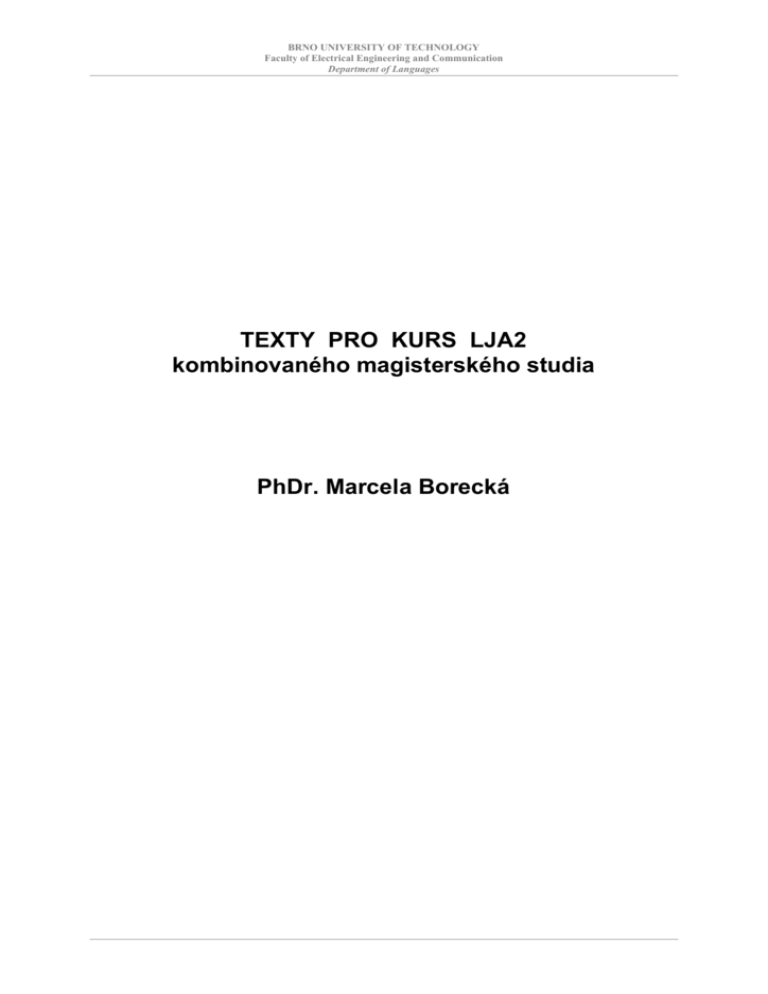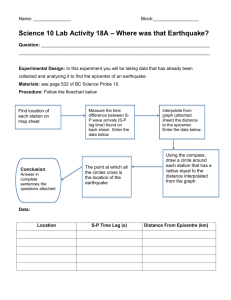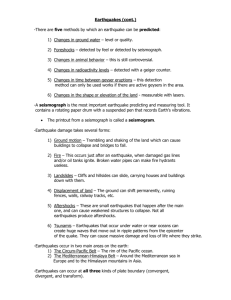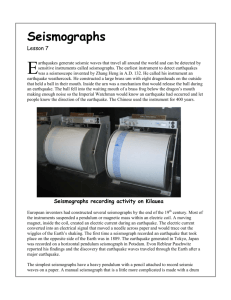Earthquake detector
advertisement

BRNO UNIVERSITY OF TECHNOLOGY Faculty of Electrical Engineering and Communication Department of Languages TEXTY PRO KURS LJA2 kombinovaného magisterského studia PhDr. Marcela Borecká BRNO UNIVERSITY OF TECHNOLOGY Faculty of Electrical Engineering and Communication Department of Languages Specialized Course in Reading Skills Earthquake detector 1) A seismograph is an instrument that locates the origin and force of earthquakes. Although there are many different types of seismographs in use around the world, they all rely on the same principle. One part of the instrument remains stationary, or nearly so, while another shakes with the earth’s tremors. 2) Earthquakes generate waves that travel through the earth and cause the ground to vibrate as they arrive at its surface. These are called seismic waves. There are four different types of seismic waves and they all travel at different speeds. 3) To locate the origin or epicentre of an earthquake, several seismographs are placed at different locations. By comparing the arrival times of different waves at these, the epicentre of the earthquake can be found. 4) The electromagnetic seismograph (illustrated) consist of a coil of wire fixed to the base of the instrument. It is arranged so that it moves in the field produced by a heavy magnet. The magnet is known as the mass. 5) Because of inertia, the magnet remains stationary. Inertia is the resistance of objects to any change in their speed, even if the object is stationary. Everything has inertia and the amount depends on its mass. The greater an object’s mass, the more inertia it has. 6) During an earthquake, the magnet remains still and the coil vibrates. As it does so, it produces a varying electric current which is roughly proportional to the ground motion. This signal is amplified and fed into a computer. The computer converts the current into a fluctuating line which can be recorded on a chart. 7) Earthquakes are measured on a scale of 1 to 10 devised by Charles F. Richter in 1935. The weaker the earthquake, the closer to zero on the scale, with each unit representing a tenfold increase in strength. (Adapted from The Guardian) BRNO UNIVERSITY OF TECHNOLOGY Faculty of Electrical Engineering and Communication Department of Languages BRNO UNIVERSITY OF TECHNOLOGY Faculty of Electrical Engineering and Communication Department of Languages Specialized Course in Reading Skills Earthquake detector - TASKS A. Comprehension a) T/F 1. Various kinds of seismographs depend on the same principle. 2. Seismic waves generated by earthquakes cause vibrations on the earth‘ surface. 3. Waves which travel through the earth‘ interior travel at a different speed from those which travel through the earth‘s surface. 4. The source of earthquakes is identified through the use of different arrival times of waves at one seismograph. b) Find paragraphs which fit the following headings 1. Why the mass does not move 2. How the epicentre of an earthquake is found 3. What the parts of an electromagnetic seismograph are 4. How the seismograph works B. Vocabulary a) The words in italics are taken from the text. Group them in the three columns below as follows: ______________________________________________________________________ fluctuating, locate, amplified, coil, stationary, electric current, arranged, frame, varying, generate, amplifier, converts, seismic, mass, travel, magnetic field ________________________________________________________________ Nouns relating to the seismograph Verbs of physical action Adjectives of description BRNO UNIVERSITY OF TECHNOLOGY Faculty of Electrical Engineering and Communication Department of Languages Specialized Course in Reading Skills Earthquake detector - KEY A. Comprehension a) T/F 1. T 2. T 3. T 4. F b) 1. Why the mass does not move par. 5 2. How the epicentre of an earthquake is found par. 3 3. What the parts of an electromagnetic seismograph are par. 4 4. How the seismograph works par. 6 B. Vocabulary Nouns relating Verbs of physical action Adjectives of description to the seismograph coil to locate fluctuating el.current to arrange stationary frame to generate amplified amplifier to convert varying mass to travel seismic magnetic field










